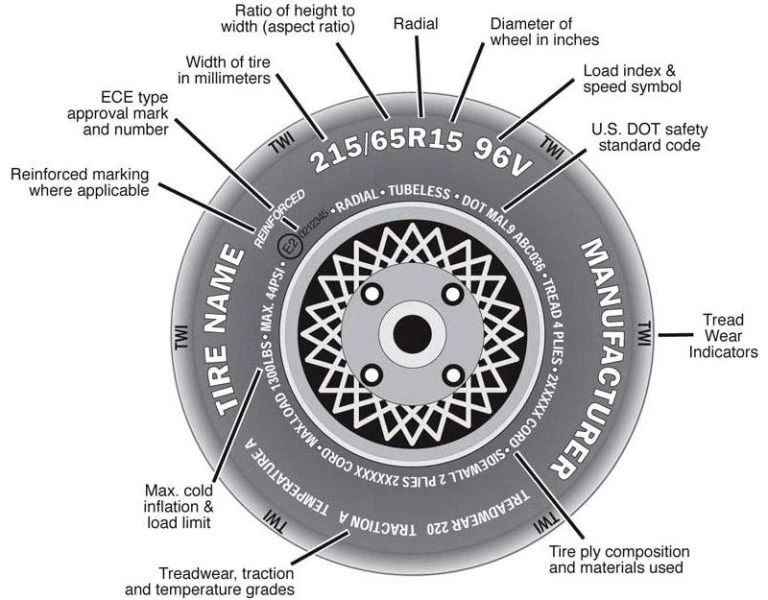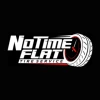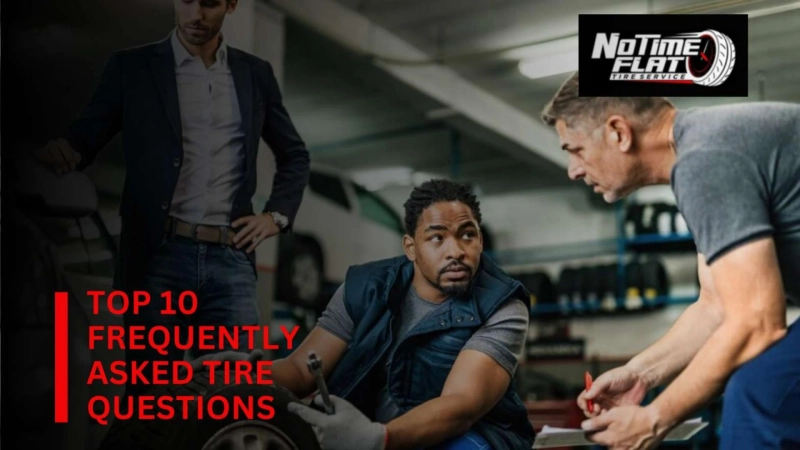Tires are necessary for the smooth operation and safety of your vehicle. But how much do you really know about maintaining them? Your vehicle\'s tires are often overlooked, but worry not! The reputed mobile tire shop experts have compiled a list of the top 10 common tire questions to provide you with the knowledge you need. From solving the tire pressure question to tire safety questions and extending their lifespan, the tire experts are here to crack the mysteries of tire maintenance together!
Question 1: What is the recommended tire pressure for my tires?
Answer 1: Using the tire pressure specified by the vehicle manufacturer is recommended. You can find this information on the Tire Information Placard, usually located on the inside of the driver\'s door jamb. It is important to stick to the recommended tire pressure and avoid deviating from it. Keep in mind that when you check tire pressure monitoring system (TPMS), the pressure requirements may vary if you choose to plus-size your tires.
Question 2: Do my O.E. (Original Equipment) tires come with a mileage warranty?
Answer 2: O.E. tires, which are designed to meet the vehicle manufacturer\'s specifications, do not typically come with a mileage warranty. However, they are warranted against workmanship and material defects. It means that if there are any issues with the quality or construction of your O.E. tires, you may be eligible for a warranty claim. It\'s always a good idea to consult the specific warranty information provided by the tire manufacturer for more details on coverage and limitations.
Question 3: What is the meaning of speed rating for tires?
Answer 3: The speed rating of a tire indicates the category or range of speeds at which your tire can safely carry a load under specific service conditions. It is represented by a letter from A to Z, indicating the tire\'s certified speed rating. The speed rating system was developed in Europe to ensure the safe performance of tires at standardized speeds.
Speed Rating | ||
|---|---|---|
Speed Symbol | Speed (km/h) | Speed (mph) |
A1 | 5 | 3 |
A2 | 10 | 6 |
A3 | 15 | 9 |
A4 | 20 | 12 |
A5 | 25 | 16 |
A6 | 30 | 19 |
A8 | 40 | 25 |
B | 50 | 31 |
C | 60 | 37 |
D | 65 | 40 |
E | 70 | 43 |
F | 80 | 50 |
G | 90 | 56 |
J | 100 | 62 |
K | 110 | 68 |
L | 120 | 75 |
M | 130 | 81 |
N | 140 | 87 |
P | 150 | 94 |
Q | 160 | 100 |
R | 170 | 106 |
S | 180 | 112 |
T | 190 | 118 |
U | 200 | 124 |
H | 210 | 130 |
V | 240 | 149 |
W | 270 | 168 |
Y | 300 | 186 |
The rating system ranges from 5 km/h (3 mph) to 300 km/h (186 mph), with each letter symbolizing a specific speed range. However, it\'s important to note that the speed rating only signifies the maximum speed for which a tire is certified and does not reflect its overall performance capability.
The Unlimited H category initially represented the highest speed rating at over 210 km/h (130 mph). As tire manufacturers started producing tires that exceeded this category, the Limited V category of 240 km/h (149 mph) was introduced, along with the Z speed rating as the top speed rating for tires. Additional symbols like W and Y were added for higher speed categories.
To know the maximum speed of Unlimited Z tires, it is recommended to consult the manufacturer. The speed rating is typically identified as part of the tire\'s sizing or service description. In an attempt to standardize tire designations, most ratings incorporate the speed symbol and load index as the tire\'s service description.
For instance to answer the tire size questions, when the "ZR" designation appears in the tire size with the service description, the maximum speed is indicated accordingly. A "ZR" might appear in a size designation for those tires with a maximum speed capability above 240 km/h (149 mph). Tires with a maximum speed capability above 300 km/h (186 mph) must have a "ZR" in the size designation. In cases with no service description, it is advisable to consult the mobile tire shop expert for the maximum speed.
Question 4: What does UTQG mean?
Answer 4: UTQG, or Uniform Tire Quality Grading, provides comparative data to assist consumers in purchasing regular and all-season tires. It includes three categories: Treadwear, Traction, and Temperature. Here\'s what you need to know:
- Treadwear: Compares the wear rate of a tire to a reference tire under controlled test conditions. For example, a tire with a grade of 150 would wear 1.5 times better than a tire with a grade of 100. Actual performance may vary based on driving habits and road conditions.
- Traction: Assesses a tire\'s ability to stop a vehicle on wet pavement. Grades range from AA (highest) to C (lowest). Ice and snow traction capabilities may not be not tested.
- Temperature: Indicates a tire\'s resistance to heat buildup. Maintaining proper tire inflation and avoiding overloading is important to prevent tire failure.
You need to know that UTQG grades are assigned by tire manufacturers and are not government grades. They are not a guarantee for mileage warranties or overall tire quality. UTQG grades are not safety ratings; tire selection should not rely solely on them. UTQG grades are not required for your snow tires, light truck tires, and maximum traction tires.
Question 5: What is the proper way to rotate tires?
Answer 5: To ensure even tire wear and maintain performance, make sure that the below guidelines are followed during tire rotation service as well as tire balancing service:
4-Tire Rotation: Front tires wear out faster on front-wheel drive vehicles. Rotate all four tires regularly to distribute wear evenly. On average, rotate tires every 5,000 miles, or more frequently for high-performance tires.
Wheel Balancing: If you feel steering wheel vibration between 50 and 70 miles per hour, it may indicate out-of-balance wheels. Wheel balancing must be done with every tire rotation to improve handling and fuel efficiency.
Following these steps can extend tire lifespan and allow you to enjoy a smoother driving experience.
Question 6: What should I know about tire repair?
Answer 6: Proper tire repair is essential for safety and reliability. Here\'s what you need to know:
- Complete Inspection: A qualified tire repair services professional should demount the tire for a thorough inside and out inspection. Some damage may only be visible on the interior.
- Repair Criteria: Proper tire repair addresses puncture injuries that are ¼ inches (6 mm) or smaller and located within the tread area. This ensures long-term durability.
- Repair Process: A patch is applied to the tire\'s interior, sealing the puncture hole with a suitable plug/stem filler. This prevents inflation pressure loss and contamination of the tire\'s structure.
Please note:
- Not all tires can be properly repaired, and some may need replacement. Never repair a tire with worn tread indicators, punctures larger than ¼ inch, damage outside the repairable tread area, or pre-existing improper repairs.
- Tire repairs should always involve demounting the tire from the wheel to inspect for hidden damage.
- Using only a plug/stem or only a patch may not be a safe or proper repair. Both should be used together to ensure integrity.
- Never ever substitute a tube for a proper repair or to fix an improper repair. Tubes, like tires, should be repaired by a qualified professional.
- Please check your vehicle owner\'s manual or contact the manufacturer for information on using repaired tires, as some manufacturers may not recommend it.
- If a tire has been repaired, its original speed rating is void. It must be treated as a non-speed rated tire.
Question 7: How do I read the sidewall of my tires?
Answer 7: The sidewall of your tires contains valuable information. Here is an example of what tire sidewall information looks like:
Question 8: What is the repairable area of a tire?
Answer 8: For non-run flat tires (non-RFT), repairs should follow the recommended procedures of the Rubber Manufacturers Association (RMA). Some punctures may not be visible, so additional measures like using soapy water and tire water tubs are taken to identify them.
For run-flat tires (RFT):
- RFT tires can be rendered unusable due to punctures, road hazards, or improper run-flat or low-pressure operation.
- Factors affecting repairability include vehicle speed, load, handling, inflation pressure loss, and ambient temperature.
- RFT tires cannot be repaired in various situations, such as when the tire is labeled "Do Not Repair" on the sidewall, operated with low inflation pressure, or has abrasion/wrinkling/separation on the exterior or interior areas.
- Run-flat tire services providers can inspect the tire thoroughly to check if it can be repaired, as tire damage may not always be visible from the outside.
Some vehicle manufacturers advise against using repaired tires, particularly RFT tires, to avoid damage, injuries, or fatalities. Before using a repaired tire on your vehicle, consult your vehicle owner\'s manual or contact the manufacturer for guidance.
Question 9: Why did my tires wear so quickly?
Answer 9: Premature tire wear can occur due to various factors, including:
Improper inflation
Driving conditions
Misaligned vehicles
Worn vehicle parts
And many other reasons.
To determine the specific cause of your tires wearing prematurely, it is recommended to have a trained professional physically inspect them. With a thorough inspection, it is easier to pinpoint the exact reason. Visit a mobile tire shop where professionals can inspect your tires and provide an accurate assessment.
Question 10: What is the rolling resistance of my tires?
Answer 10: Rolling resistance is the force required to roll a tire against a dynamometer at a fixed speed. It is typically measured using the SAE (Society of Automotive Engineers) test procedure J1269. The rolling resistance of tires can vary depending on factors such as tread compound, construction, size, and tread pattern.
Since numerous tire products are available, each with variations in rolling resistance, it is challenging to provide specific values for all tires. Estimation is often required, and independent organizations make these estimates based on testing. It is important to note that the rolling resistance values provided are estimates and may not align precisely with specific tire sizes or patterns.
That\'s All!
Care for Your Tires, Your Tires Will Care for You!
Now that you have gained a better answers for your tire questions, it is important to prioritize safety precautions and proactive maintenance. Regularly inspecting your tires, maintaining proper inflation, and addressing issues early can help prolong their lifespan and enhance your overall driving experience.
Remember, if you need to purchase new tires, consider contacting a reliable mobile tire shop offering an extensive selection of tires and expert tire installation service. By taking these necessary steps and consulting experts for further tire questions, you can ensure the safety and longevity of your tires, contributing to a smoother and more enjoyable journey on the road.



